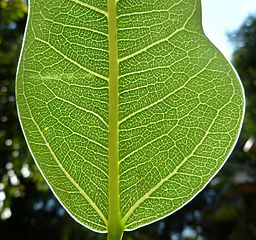
Ficus is a genus of about 850 species of woody trees, shrubs, vines, epiphytes and hemiepiphytes in the family Moraceae. Collectively known as fig trees or figs, they are native throughout the tropics with a few species extending into the semi-warm temperate zone. The common fig (F. carica) is a temperate species native to southwest Asia and the Mediterranean region, which has been widely cultivated from ancient times for its fruit, also referred to as figs. The fruit of most other species are also edible though they are usually of only local economic importance or eaten as bushfood. However, they are extremely important food resources for wildlife. Figs are also of considerable cultural importance throughout the tropics, both as objects of worship and for their many practical uses.

The Wonderboom Nature Reserve is a 1 km², 200-hectare reserve that incorporates a section of the Magaliesberg range in the northern portion of the Pretoria metropole, South Africa. Its main attractions are the Wonderboom near the reserve entrance in Lavender street and the derelict Fort Wonderboompoort on the crest of the Magaliesberg, that was constructed towards the end of the nineteenth century, during the Second Boer War. The latter is reached by following the steep, paved walkway that leads from the picnic area to the summit. The vicinity of the fort ruins also afford sweeping views of the city, whose council declared the area around the Wonderboom and both banks of the Apies River a reserve on 28 December 1949.
The Pondoland fig is a species of fig that is endemic to forests of coastal South Africa, where it is threatened by habitat loss.

Myrina silenus, the common fig-tree blue, is a butterfly of the family Lycaenidae. It is found in Sub-Saharan Africa, southern Arabia and northern Oman.

Ficus septica is a shrub or tree of the family Moraceae living at low altitudes from northeast India to north Australia (Queensland), and throughout Malesia. It lives on the edge of the vegetation, often in degraded environments. The seeds of this species are dispersed by numerous species, including fruit bats (Megachiroptera) when present.

Combretum erythrophyllum, commonly known as the river bushwillow, is a medium to large-sized, spreading tree found in bush along river banks in southern Africa. It is planted as a shade and ornamental tree in South Africa and the United States, and is propagated by seed.

Ficus sur, with the common names Cape fig and broom cluster fig, is a widespread Afrotropical species of cauliflorous fig.

The Ficus sansibarica, known as knobbly fig, is an African species of cauliflorous fig. It is named after Zanzibar, where Franz Stuhlmann discovered it in 1889. They often begin life as epiphytes, which assume a strangling habit as they develop. They regularly reach 10 m, but may grow up to 40 m tall as forest stranglers.

Ficus craterostoma, a species of strangler fig, is a fig shrub or tree of the Afrotropics that may grow up to 20 m tall. It is found in lowland tropical and swamp forests in the west, or in afromontane forests, including rocky situations, along Africa's eastern escarpments. The western and eastern populations may constitute separate species, as they occur at different altitudes where their ranges meet in central Africa, while they seem to have exclusive pollinating wasp species.

Ficus ingens, the red-leaved fig, is a fig species with an extensive range in the subtropical to dry tropical regions of Africa and southern Arabia. Despite its specific name, which means "huge", or "vast", it is usually a shrub or tree of modest proportions. It is a fig of variable habit depending on the local climate and substrate, typically a stunted subshrub on elevated rocky ridges, or potentially a large tree on warmer plains and lowlands. In 1829 the missionary Robert Moffat found a rare giant specimen, into which seventeen thatch huts of a native tribe were placed, so as to be out of reach of lions.
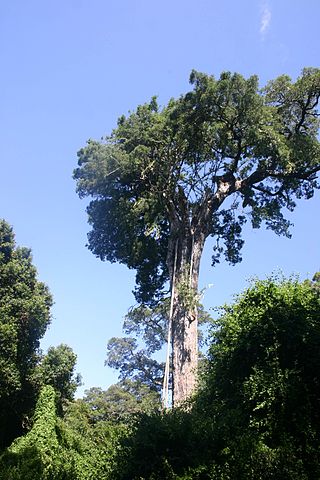
Ficus burtt-davyi is a fig species endemic to Southern Africa, belonging to the Mulberry family of Moraceae. It grows in coastal and inland forests up to 1500m, from the vicinity of Mossel Bay in the Southern Cape to southern Mozambique - the forms growing on coastal dunes in the northern part of its range are salt tolerant and form low thickets on the margins of woodland. In the southern and eastern Cape forests the species becomes a strangler or liane, while when found on rocky outcrops and cliffs it usually develops into a rock-splitter.

Ficus cordata, the Namaqua rock fig, or Namaqua fig is a species of fig that occurs in two disjunct populations in Africa, one in the arid southwest of the continent, and a second in the northern subtropics. In the south it is often the largest and most prominent tree, and is virtually restricted to cliff faces and rock outcrops, where it has a rock-splitting habit.
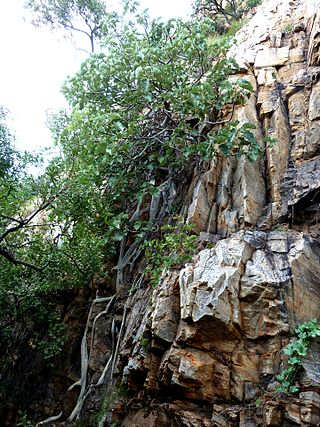
Ficus abutilifolia, the large-leaved rock fig, is a species of African rock-splitting fig that occurs in two disjunct regions, one population north, and another south of the equator. The two populations are pollinated by different fig wasps, and are morphologically distinct. It is named for the similarity of its broadly ovate leaves to that of Abutilon. It is virtually restricted to cliff faces and rock outcrops, and is easily recognized from its large, glabrous leaves and smooth, pale bark.
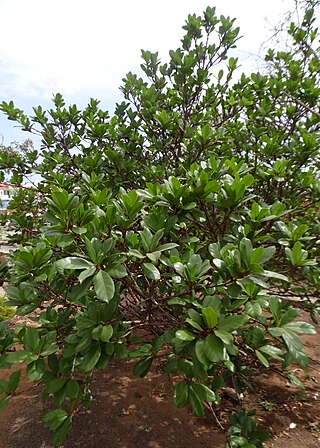
''Ficus cyathistipula'', the African fig tree, is a species of fig that is native to the tropical forest regions of Africa. They may be small trees, shrubs or hemi-epiphytic lianas, and are widespread in the moist tropics, where they may be found in Afromontane or rainforest, often overhanging pools. The figs are reddish when ripe, and have thick, spongy walls that enable them to float on water. They are named for their cup-shaped (cyathus-) and persistent stipules (stipula).
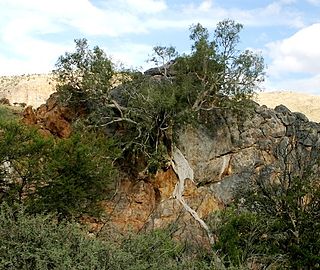
The Laurel fig is a species of rock-splitting fig that is native to the semi-desert regions of southwestern Africa. It is only found on rocks, up to an altitude of 1,300 m (4,300 ft).

Ficus polita, the heart-leaved fig, is a species of fig that is native to forests of tropical Africa,

Boscia foetida, commonly known as the stink shepherd's tree and the smelly shepherd's bush, is an evergreen shrub or tree that is native to the warmer and drier parts southern Africa. It is found in semi-desert and arid bushveld, and in the west it occurs commonly in areas which are otherwise sparsely wooded. It is known for the particularly unpleasant smell of its flowers which appear during early spring, to which its specific name foetida alludes. Its freshly cut wood likewise has an unpleasant smell, and has traditional medicinal and magical uses, for instance as a protection against lightning. In central Botswana the village of Mopipi is named after this species.

The Wonderboom is a dense grove of parent and daughter trees of the species Ficus salicifolia, that descended from a central bole of about a thousand years old. It is situated in the Wonderboom Nature Reserve, Pretoria, and two circular walkways currently protect it from pedestrian traffic around its trunk and roots. As it has grown, its outlying branches have rooted themselves around the parent tree. This has repeated until there are now three layers of daughter trees encircling the mother fig, with 13 distinct trunks, covering an area with a diameter of over 50 metres.

Ficus amplissima, also known as the Indian Bat tree, Indian Bat fig, Pimpri, Pipri (Piparee), Pipali or Bilibasari mara is a tree species of flowering plants that belongs to Moraceae, the fig or mulberry family. It is native to Central and southern Peninsular India, Sri Lanka and Maldives, having a significant distribution throughout Western Ghats of India. It is most commonly planted to provide shade in coffee plantations due to its dense and wide foliage. The ripened figs attract many birds, especially during the spring.


